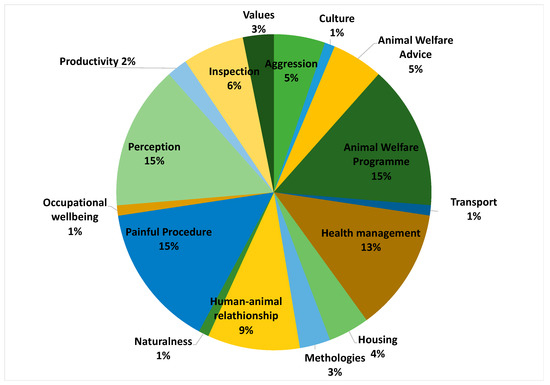Animal welfare concepts encompass biological functioning in terms of health, growth and productivity; the animals’ affective state; and naturalness of the animals’ life, especially with regard to the ability to perform the normal behaviour repertoire. Farmers are responsible to produce food and they play a key role in improving the welfare of their animals. Farmers interpersonal and external characteristics can influence their decision-making process. For example, farmers' empathy for animals influences the adoption of animal welfare practices. An extensive overview of how the farm animal welfare concepts have been perceived by farmers and a thematic analysis of the characteristics that influence this perception can lead to future directions on implementation of farm animal welfare innovation. The review further highlights the need for promoting interdisciplinary collaboration and stakeholder participation. This study suggests strategies to improve farm animal welfare, including tools to support behavioral changes amongst farmers.
- farm animal welfare
- farmers
- perceptions
- attitudes
- empathy
- human animal relationship
- policy
- stakeholders
- communication
- knowledge transfer
1. Introduction
2. Animal Welfare Topics of the Studies

References
- Amos, N.; Sullivan, R. The Business Benchmark on Farm Animal Welfare 2016 Report. SSRN Electron. J. 2017. [Google Scholar] [CrossRef]
- Freire, R.; Nicol, C.J. A bibliometric analysis of past and emergent trends in animal welfare science. Anim. Welf. 2019, 28, 465–485. [Google Scholar] [CrossRef]
- Dwyer, C.M.; Conington, J.; Corbiere, F.; Holmoy, I.H.; Muri, K.; Nowak, R.; Rooke, J.; Vipond, J.; Gautier, J.M. Invited review: Improving neonatal survival in small ruminants: Science into practice. Animal 2015, 10, 449–459. [Google Scholar] [CrossRef] [PubMed]
- Green, L.E.; Kaler, J.; Wassink, G.J.; King, E.M.; Grogono Thomas, R. Impact of rapid treatment of sheep lame with footrot on welfare and economics and farmer attitudes to lameness in sheep. Anim. Welf. 2012, 21, 65–71. [Google Scholar] [CrossRef]
- European Commission, European Union Strategy for the Protection and Welfare of Animals 2012-2015. Available online: https://ec.europa.eu/food/sites/food/files/animals/docs/aw_eu_strategy_19012012_en.pdf (accessed on 16 July 2020).
- Seabrook, M.F. The psychological interaction between the stockman and his animals and its influence on performance of pigs and dairy cows. Vet. Rec. 1984, 115, 84–87. [Google Scholar] [CrossRef]
- Hemsworth, P.H.; Barnett, J.L.; Coleman, G.J.; Hansen, C. A study of the relationships between the attitudinal and behavioural profiles of stockpersons and the level of fear of humans and reproductive performance of commercial pigs. Appl. Anim. Behav. Sci. 1989, 23, 301–314. [Google Scholar] [CrossRef]
- Adler, F.; Christley, R.; Campe, A. Invited review: Examining farmers’ personalities and attitudes as possible risk factors for dairy cattle health, welfare, productivity, and farm management: A systematic scoping review. J. Dairy Sci. 2019, 102, 3805–3824. [Google Scholar] [CrossRef]
- Peden, R.S.E.; Akaichi, F.; Camerlink, I.; Boyle, L.A.; Turner, S.P. Factors Influencing Farmer Willingness to Reduce Aggression between Pigs. Animals 2018, 9, 6. [Google Scholar] [CrossRef]
- Vaärikkala, S.; Artukka, S.M.; Hänninen, L.; Nevas, M. Finnish cattle and pig farmers’ perceptions of animal welfare inspections. Anim. Welf. 2018, 27, 369–377. [Google Scholar] [CrossRef]
- Hansson, H.; Lagerkvist, C.J.J. Dairy farmers’ use and non-use values in animal welfare: Determining the empirical content and structure with anchored best-worst scaling. J. Dairy Sci. 2016, 99, 579–592. [Google Scholar] [CrossRef]
- Heise, H.; Theuvsen, L. German dairy farmers’ attitudes toward farm animal welfare and their willingness to participate in animal welfare programs: A cluster analysis. Int. Food Agribus. Manag. Rev. 2018, 21, 1121–1136. [Google Scholar] [CrossRef]
- von Hardenberg, L.; Heise, H. German Pig Farmers’ Attitudes Towards Farm Animal Welfare And Their Willingness To Participate In Animal Welfare Pro-grams: An Empirical Study. Proc. Food Syst. Dyn. 2018. [Google Scholar] [CrossRef]
- Becker, J.; Reist, M.; Steiner, A. Factors influencing the attitudes of cattle veterinarians, farmers, and claw trimmers towards the pain associated with the treatment of sole ulcers and the sensitivity to pain of dairy cows. Vet. J. 2014, 200, 38–43. [Google Scholar] [CrossRef] [PubMed]
- Vaarst, M.; Paarup-Laursen, B.; Houe, H.; Fossing, C.; Andersen, H.J. Farmers’ Choice of Medical Treatment of Mastitis in Danish Dairy Herds Based on Qualitative Research Interviews. J. Dairy Sci. 2002, 85, 992–1001. [Google Scholar] [CrossRef]
- Horseman, S.V.; Roe, E.J.; Huxley, J.N.; Bell, N.J.; Mason, C.S.; Whay, H.R. The use of in-depth interviews to understand the process of treating lame dairy cows from the farmers’ perspective. Anim. Welf. 2014, 23, 157–165. [Google Scholar] [CrossRef]
- Dessart, F.J.; Barreiro-Hurlé, J.; van Bavel, R. Behavioural factors affecting the adoption of sustainable farming practices: A policy-oriented review. Eur. Rev. Agric. Econ. 2019. [Google Scholar] [CrossRef]
This entry is adapted from the peer-reviewed paper 10.3390/ani10091524
